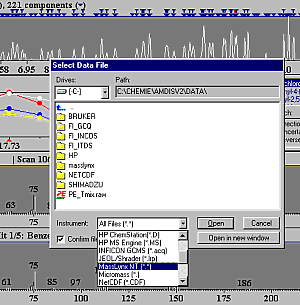| |||||||||||||||||||||
Detailed Information about AMDIS AMDIS can help you to analyze GC-MS data of complex mixtures, even with strong background and coeluting peaks. If you are working in SIM mode and you have external standards and want to quantify your compounds, you dont need AMDIS. But if you have a noisy TIC spectra file and you want to find and identify known or unknown substances - AMDIS is the first choice.
What is this AMDIS not: After reading the text you may notify that this AMDIS is not that AMDIS (Association of Medical Directors of Information Systems) nor that AMDIS Atomic and Molecular Data Information System). (Read all the text and hate the joke? E-mail me!) AMDIS is not a tool for quantification of GC-MS data. How AMDIS works: AMDIS analyses steps: 1. noise analysis, 2. component perception, 3. spectrum deconvolution, 4. compound identification. First AMDIS analyzes the background and calculates a noise level for later processing. After that, it analyzes the data for an increase of a special ion trace. If there is maxima also for other traces at the same time, is assumes there is a peak and shapes a model peak. In the next step it calculates a "clean" spectra for each peak. And at last it identifies the compound via a library search. Indeed its more complicated. You can read it in the AMDIS Method Paper: "An Integrated Method for Spectrum Extraction and Compound Identification from GC-MS Data" by Steven E. Stein AMDIS needs:
AMDIS32 V2.1 can handle files from: Bruker (*.msf)
HP Benchtop and MS Engines (*.ms) HP Chemstation (*.d) Inficon GCMS (*.acq) MassLynx NT Formats (*.*) MicroMass (*.) NetCDF (*.netCDF) Perkin-Elmer Turbo Mass (*.raw) Saturn SMS (*.sms) Shimadzu MS Files (*.R##) Shrader/GCMate (*.lrp) Varian Saturn Files (*.ms) Xcalibur (*.raw) |
[Home] [What is AMDIS?] [Chemometrics] [People] [External] [SiteMap] [About] |
© 2003 Tobias Kind - www.amdis.net - Alle Rechte vorbehalten. |
